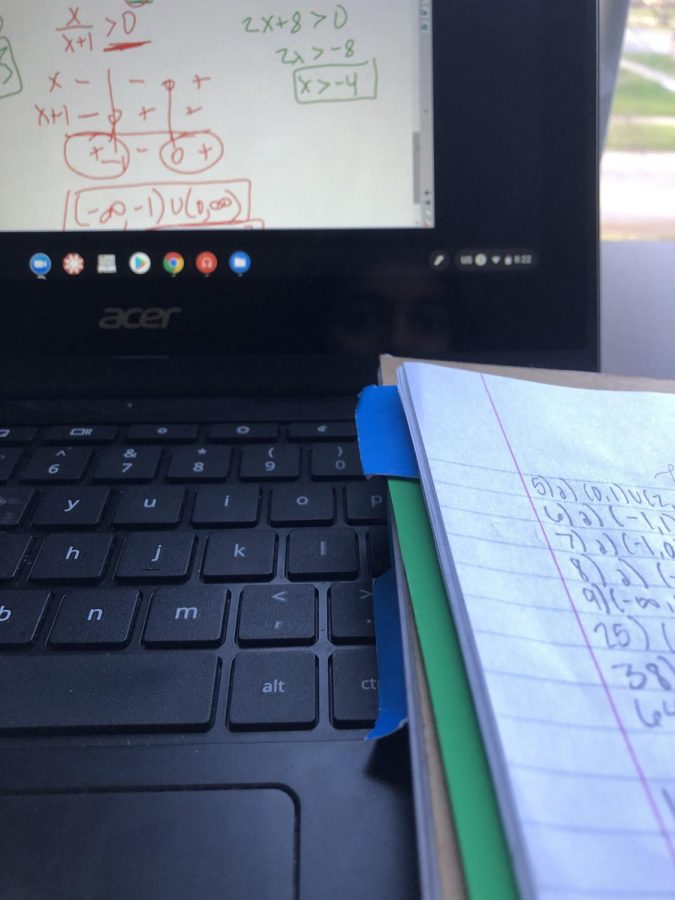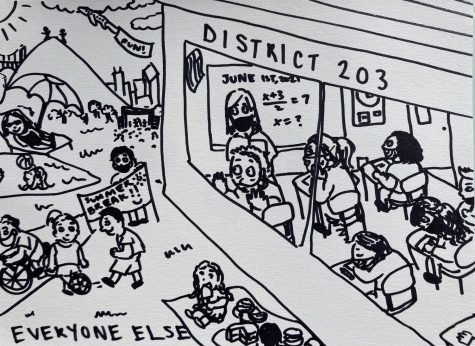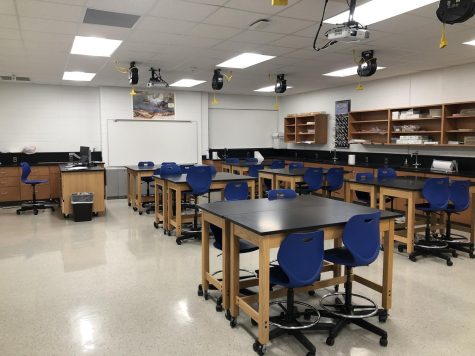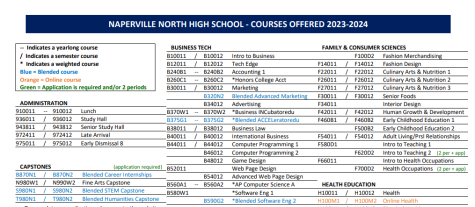Students and teachers struggle with breaks in extended class periods
Photo by Reyah Doshi
Many Naperville North students feel they are not getting enough breaks within each period under the block schedule.
With four nearly back-to-back 85 minute periods every day, it can be hard to find time to look away from the screen. Students and teachers alike recognize the implications of the extended screen time, and AP Economics teacher Eleanor Barbino has noticed a trend among students when they don’t get breaks.
“If you go the full 85 minutes without giving the students a break, you kind of lose them. You can tell that they’re not as attentive,” Barbino said.
The block schedule, which went into effect on Oct. 19 as part of the District 203’s Return to Learn Plan, has drastically changed the way online school looks, implementing class periods much longer than current North students have ever experienced. Taking breaks throughout the day becomes increasingly important with long classes, but it’s hard to find a clear-cut way to make that happen. Students understand that it is difficult for teachers to balance their curriculum with the screen breaks, NNHS senior Sophie Tranor explained.
“This must be hard to navigate especially for the teachers because they have to get through their content. Even though we should have more breaks, I’m sure most teachers can’t just cut content to make that happen,” Tranor said.
Certain classes allow for more flexibility of curriculum than others. When teachers are in charge of their own curriculum, like Sports Medicine and Strength and Performance teacher Jason Majchrowski, they can take some liberties in discarding content to make room for breaks.
“For Sports Medicine, I can adapt and adjust it as I see fit because I’m the only one who teaches it. I can throw stuff out where I need to, and I know that might not be the same across other departments,” Majchrowski said.
In AP classes, teachers work to prepare students for an exam in the spring. They must teach the curriculum pre-set by the College Board, hindering their ability to discard a piece of content to make time for breaks.
“With AP, they give you the curriculum. You don’t get to say ‘well, we’re going to skip this part,’” Barbino said.
Along with the inconsistencies in teachers’ ability to add in breaks, students’ feelings about the amount of necessary break time varies between classes as well. The format of teaching in math classes specifically calls for more break time, according to NNHS senior Hadley Parr.
“With math, it’s hard to be lectured at for 85 minutes. Even if they give us a four minute break, we can’t really go anywhere, we’re still just going to be sitting at our computers,” Parr said.
The online format of math has required an adjustment of the curriculum and communication between math teachers to allow more accommodation of students’ needs, as described by math teacher Katherine Papagiannis.
“We’ve changed the timing significantly, and it’s taken a lot of discussion between teachers to figure out what to de-emphasize this year to make things more manageable,” Papagiannis said.
Even AP calculus teacher Elizabeth Moore, constrained both by AP content and by the unique challenges that teaching online math poses, works to give students more off-screen time.
“Sometimes I just have so much material that I can’t take as long of a break as I would like to, but I’ve been trying to adjust my lesson to get breaks in for as long as I can,” Moore said.
Students share a common concern over not only the frequency, but the length of breaks. NNHS sophomore Michael Magana argues that teachers need to extend break times, even if it comes with a tradeoff.
“Three to five minute breaks isn’t long enough to do much and that’s what teachers usually give, if they give breaks at all. I would rather have a little more homework and a longer break,” Magana said.
Teachers have had to come up with innovative solutions to the focus issue, some of them emphasize getting away from the screen and being active during a given break.
“We might put up a timer and say ‘do 10 jumping jacks, grab a snack and go to the bathroom during the break,’” Papagiannis said.
In addition to improved student attentiveness as a motivator for teachers to incorporate Zoom breaks, the school administration reminds teachers to do so.
“There’s been general guidelines about instructional minutes, and the school administration told us that we need to give students breaks and time away from the screen,” Majchrowski said.
There are many factors to consider in the topic of breaks within the block schedule, and even more when discussing online learning as a whole. In a tumultuous time, both North teachers and students seem to be doing their best to navigate online block-style learning.
“We don’t give enough credit to the teachers and we don’t give enough credit to ourselves because nobody knows exactly what’s going on right now,” Tranor said.

Reyah is a senior at North and is excited to take on the role of Editor-in-Chief in her third year writing for The North Star. This year, she hopes to...
















